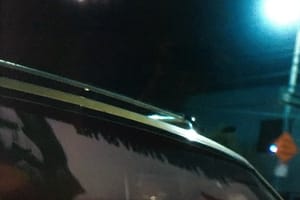
Night Stalker, the Netlix docuseries about Richard Ramirez and his 1980s killing spree, is filled with shots you may not want to see. But one moment worth catching is the brief reflection of Charles Manson on the windshield of Ramirez’s car.
It happens about 15 minutes and 15 seconds into the second episode, and lasts a mere two seconds. Detective Frank Salerno, who partnered with Detective Gil Carillo to try to identify and capture the murderer, rapist and child molester known as the Night Stalker, is describing a pentagram that Ramirez wrote on the wall of the crime scene. He says he and Carillo initially struggled to understand its significance.
“We knew what a pentagram was but we didn’t know what that meant as far as the killer,” Salerno says. “Was he trying to leave us a message? Was he into Satanism? Was it something he believed in? Was it something he practiced?”
Salerno adds: “Maybe he was copycatting… Manson?”
At this, a blink-and-you’ll-miss-it image creeps into one of the many re-creations of Ramirez driving around Los Angeles. We don’t see Ramirez, but we do see a billboard reflected on his windshield. And the person on the billboard certainly appears to be Charles Manson.
Also Read: Meet Doreen Lioy, the Woman Who Married Richard Ramirez in Prison
Manson, whose own 1960s killing spree has been the subject of endless films and documentaries (the latest twist on the story is Quentin Tarantino’s Once Upon a Time… in Hollywood) was known for instructing his lackeys to write messages on the walls of victims’ homes.
Night Stalker director Tiller Russell has drawn some criticism for the graphic recreations of crime scenes included in the docuseries.
“We do not need to see a single drop of blood in slow-motion as it falls to the ground,” Ann Donahue wrote in a review for IndieWire. “We do not need to see a blood-covered hammer drop alongside it.”
Russell was not available for an interview, Netflix said.
While his directorial flourishes may be divisive, the Manson shot is one, that for me, works exactly as intended: It represents the ghastly specter the Manson killings cast over Southern California, and frames it using the most familiar of Southern California images, the billboard, cast onto another symbol of Southern California, the car windshield. A surface that should represent clarity and freedom and clarity is tainted revulsion and fear.
The other re-creations, of crime scenes, run the risk of being seen as exploitive and leering. But the Manson reflection is different; the billboard doesn’t do any physical violence. It just cast a pall over what could otherwise be seen as an innocent drive. It’s a feeling that will be familiar to anyone who drives through Hollywood, or the San Fernando Valley, or Hollywood Hills, and then flashes for no reason on the grim horrors that have fallen across them all.
Night Stalker never answers the question of whether Ramirez was imitating Manson. But when Salerno meets Ramirez, upon his his arrest, the detective notes that Ramirez seemed to be a student of past serial killers, and seemed excited to be placed in the jail cell that once held one of the Hillside Stranglers, Kenneth Bianchi.
Night Stalker is now streaming on Netflix.
